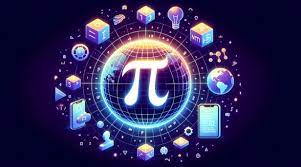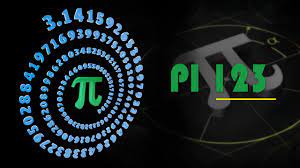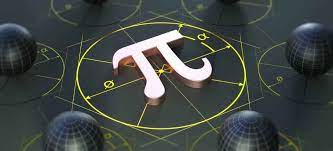Pi, denoted by the Greek letter π, stands as a timeless mathematical constant with a rich history spanning millennia.
Its definition involves the ratio of a circle’s circumference to its diameter and is approximately 3.14159. Beyond its numerical value, pi captivates mathematicians with its unique properties and the intriguing fact that its decimal representation extends infinitely.
Join the celebration of this timeless constant – your journey into the mysteries of math begins here!
Exploring the Wonders of Pi – An Infinite Journey into Irrationality!
Pi, a captivating mathematical constant, unveils its enigmatic nature through its status as an irrational number. This unique characteristic means that pi’s decimal representation is infinite and non-repeating, defying expression as a simple fraction or terminating decimal.

Despite our reliance on the familiar 3.14, the true essence of pi remains elusive, with scientists employing advanced computing to unveil its trillions of decimal digits.
Beyond its numerical intrigue, pi finds a place of celebration in Pi Day on March 14th, denoted as 3/14. However, the influence of pi extends far beyond festivities, embedding itself in the very fabric of our natural world.
From geometry, where it aids in measuring angles and circle-related quantities, to its indispensable role in calculus for complex calculations, pi emerges as a constant companion in diverse fields such as physics, engineering, statistics, and even the harmonious realm of music.
Join us on this infinite journey where Pi’s wonders stretch beyond mathematical boundaries.
Read: SLS Lifestyle – A Simple Guide To Sustainable Living!
The background and past of pi123 – Join The Mathematical Elite!
The concept of pi has been studied for thousands of years by ancient civilizations. The ancient Egyptians, around 1650 BCE, used an approximation of 3.16 for pi. It was later determined more accurately by the Greek mathematician Archimedes in the 3rd century BCE.
Indian mathematicians in the 8th century CE introduced a symbol to represent the ratio of a circle’s circumference to its diameter.
This symbol, known as “pi,” was later adopted by Islamic scholars and brought to Europe during the Middle Ages.
Archimedes, in the 3rd century BCE, calculated pi accurately by using polygons inscribed and circumscribed around a circle.
Chinese mathematician Zu Chongzhi, in the 5th century CE, calculated pi to seven decimal places using a similar approach.
Madhava from India improved this method in the 14th century CE, calculating pi up to eleven decimal places.

In the modern era, calculating pi has become a competition among mathematicians. In 1706, German mathematician Johann Lambert calculated it correctly up to a certain number of decimal places.
Applications of pi123 in Different Fields – Celebrate The Beauty Od Circles!
Pi123, an irrational number, has captivated thinkers across various disciplines for centuries. Its utility spans multiple domains, becoming a pivotal constant in equations and computations.
Let’s delve into key areas where pi123 plays a crucial role and explore how its value drives advancements.
1. Mathematics:
Pi123 holds a foundational role in mathematics, serving as a key constant in geometric formulas. It contributes to calculations involving the area, circumference, volume, and surface area of circles and spheres.
Additionally, pi123 appears in trigonometric equations, such as those governing sine, cosine, and tangent functions. Its absence would leave many mathematical equations incomplete or unsolvable.
2. Physics:
In the realm of physics, pi123 is integral. From Newton’s law of gravitation to Einstein’s theory of relativity, pi123 influences the verse physical phenomena, including waveforms, oscillations, and energy transfer calculations.
For instance, its presence in the formula for angular velocity plays a crucial role in determining the frequency and wavelength of periodic waves.
3. Engineering:
Engineers, tasked with designing structures and machinery for real-world conditions, heavily rely on accurate calculations. Pi123 comes into play in scenarios involving rotational motion and circular structures like wheels or flywheels.

Its significance extends to determining stress and strain on curved beams, contributing to the robustness of engineering designs.
Read: Is It A Sin To Watch Movies With Magic? – 2023 Guide Here!
Benefits and drawbacks of utilizing pi123 – A Journey Of Discovery!
The widespread use of pi extends into the realm of computing technology, where programs and algorithms have emerged to produce extensive digit sequences beyond the decimal point, reaching into the millions or even billions.
An example of such technology is Pi123, a web-based tool specifically crafted to compute and showcase the initial million decimals of pi.
Much like any other tool or technology, utilizing Pi123 presents its own set of pros and cons. In this segment of our blog post titled “Understanding Pi: In-Depth Information,” we will delve into these positives and negatives in more straightforward terms.
1. Precision in Calculations:
Employing Pi123 ensures accuracy up to one million decimal places, a level of precision challenging for human calculations without introducing errors like typos or rounding issues encountered during manual pi calculations.
2. Time Efficiency:
In the modern world of rapid pace, time is an invaluable resource. Pi123 proves to be time-efficient by rapidly generating thousands or millions of digits without the laborious process of manual transcription.
3. Ease of Access:
Being an online tool, Pi123 is accessible from any location at any time, given internet connectivity. This enhances convenience and flexibility for users.
Interesting information about pi123 – Await Your Exploration!
- Since pi is irrational, it cannot be expressed as a fraction of two whole numbers.
- Its decimal representation is infinite and lacks a repeating pattern.
- The symbol for pi (π) was first used by mathematician William Jones in 1706 and popularized by Swiss mathematician Leonhard Euler in 1737.
- Rajveer Meena from India holds the Guinness World Record for memorizing 70,030 digits of pi.
- Despite commonly approximating pi as 3.14, computer scientists have calculated it to be over one trillion digits after the decimal point.
- Ancient civilizations struggled to accurately calculate pi due to its irrationality, leading to various historical approximations, including 22/7.
- The exact calculation of pi remains a mathematical mystery and is considered one of the greatest unsolved problems.
- Pi Day is celebrated on March 14th (3/14) globally with math and pi-related activities.
- NASA uses an estimated value of pi (3.14159) for calculating trajectories in space missions.
- There is no limit to the number of digits that can be calculated for pi, as it is an infinite number with unique mathematical properties.

FAQs:
1. What is pi?
Pi is a mathematical constant representing the ratio of a circle’s circumference to its diameter, denoted by the Greek letter π.
2. How is pi calculated?
Pi is commonly calculated using geometric methods, such as Archimedes’ method, or through advanced algorithms like the Pi123 web-based tool.
3. Why is Pi Day celebrated on March 14th?
Pi Day is celebrated on March 14th (3/14) because the numerical date 3/14 corresponds to the first three digits of the mathematical constant pi (3.14).
Conclusion:
In Conclusion,
It is the length of the perimeter allocated for the width of a circle, which equals roughly 3.14159. Pi’s distinctive qualities and the fascinating fact that its decimal representation is infinitely extended captivate mathematicians, even beyond its numerical value.













+ There are no comments
Add yours